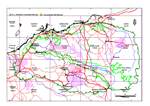Botanical name
Acacia ancistrocarpa x citrinoviridis
Description
Obconic, multi-stemmed shrubs 4-6 m tall, crown not dense. Branchlets glabrous (except on new shoots). New shoots invested with silvery appressed hairs. Phyllodes linear to narrowly lanceolate-elliptic, 13-17 cm long, 4-6 (-8) mm wide, straight to very shallowly recurved, glabrous to sparsely appressed silvery-hairy (hairs dense on new shoots); parallel longitudinal nerves numerous, fine and close together, the central one slightly more evident than the rest, with a discrete, narrow, yellowish marginal nerve ; gradually narrowed to acuminate, non-spiny apical points. Inflorescences simple; peduncles 1-2 mm long, densely or (when in fruit) moderately puberulous with spreading or appressed hairs; receptacle densely clothed with white, spreading hairs when in flower, indumentum sparser when in fruit; spikes 15-20 mm long, golden. Flowers 5-merous, small; calyx variably dissected 1/3-2/3 its length, hairy. Pods broad linear, flat but a little raised over seeds and not constricted between them, 10-12 cm long, 6-7 mm wide, ±thinly coriaceous-crustaceous, sub-straight to shallowly curved, with dense, ±appressed white hairs when young, aging glabrous and shiny. Seeds longitudinal in pods, obloid-ellipsoid, 5-6 mm long, about 4-5 mm wide, flattened, dull, brown; funicle thread-like, expanded into a relatively small, creamy white aril.
Characteristic features
New shoots silvery appressed -hairy. Phyllodes long (13-17 cm) and gradually narrowed to acuminate apices, linear to narrowly lanceolate-elliptic, straight to very shallowly recurved, glabrous to sparsely appressed silvery-hairy, finely longitudinally multi-nerved with central nerve slightly more evident than the rest, marginal nerves narrow yet discrete. Spikes on very short (1-2 mm), densely hairy peduncles; receptacle densely white-hairy. Pods broad-linear, flat, ±thinly coriaceous-crustaceous, with dense, ±appressed white hairs when young, aging glabrous and shiny. Seeds flattened.
Distribution and ecology
Known from only a single locality in the Pilbara region of northwest Western Australia where it occurs on the road between Munjina Roadhouse and Roy Hill Station, in the valley of the Fortescue River. Grows with the two putative parents and a range of other acacias, namely, A. aneura , A. dictyophleba , A. pruinocarpa , A. pyrifolia var. morrisonii, A. synchronicia , and A. tumida var. pilbarensis.
Flowering and fruiting period
The very few collections of this entity show the plants as finishing flowering in mid-May and with mature seed in late October.
Taxonomy
The hybrid status of this entity is based on field observations and morphological characteristics of the specimens collected.
Conservation status
There is insufficient information at present concerning this entity to justify including it on the Department of Environment and Conservation's Declared Rare and Priority Flora List.



